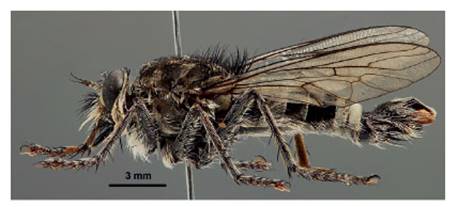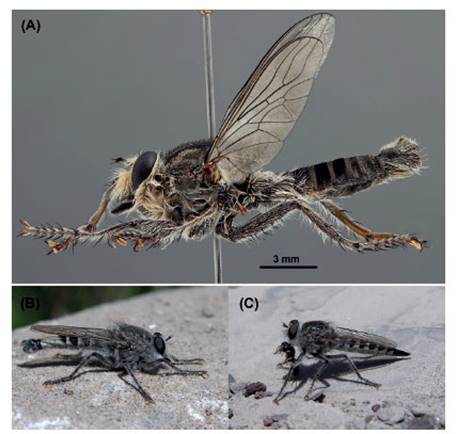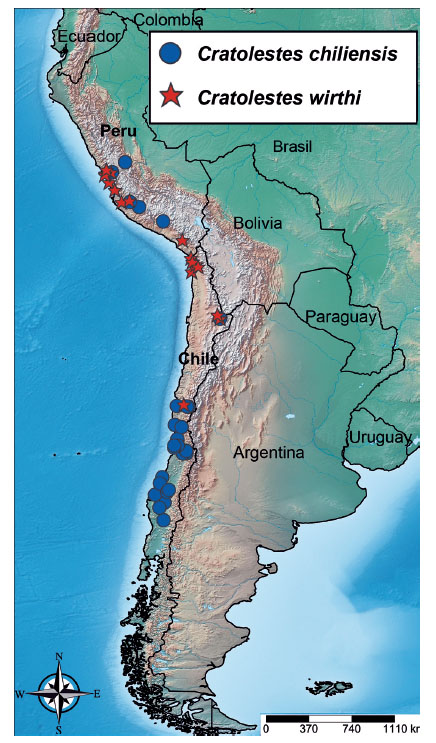Introduction
Adult robber flies (Asilidae) are opportunistic predators of other arthropods, and, as such, play an important role in natural ecosystems and crops, where they can also be regarded as indicators of good environmental health (Fisher 2009, Londt & Dikow 2017). However, like most groups of Diptera, robber flies are largely understudied in Neotropical countries, where taxonomic and distribution studies are needed for a better understanding of the diversity of this family, known to contain many undescribed species (Fisher 1985, Lamas 1972, Vieira et al. 2019).
Currently, Asilidae is classified into 14 subfamilies (Dikow 2009, Londt & Dikow 2017), with Asilinae Latreille, 1802 being one of the most diverse subfamilies, including 183 extant genera, and present in all biogeographic regions, except Antarctica (Geller-Grimm 2004, Dikow 2021, Camargo et al. 2019). In the Neotropical region, Asilinae includes 68 genera; 15 of which have been recorded from Peru, comprising at least 45 species, as Eraxasilus Carrera, 1959 and Lecania Macquart, 1838 require determination to species level, and several species deposited in scientific collections remain undescribed (Fisher 1985, Lamas 1972, Papavero 2009, Sánchez 2020).
Cratolestes Hull, 1962 is a Neotropical genus of robber flies within the subfamily Asilinae, in an unplaced tribe (Dikow 2021). This genus is only recorded from Chile (Papavero 2009) with two described species, Cratolestes chiliensis (Macquart, 1850) and Cratolestes wirthiArtigas, 1970. While examining the collection of asilid flies at the Natural History Museum of the Universidad Nacional Mayor de San Marcos, Lima, Peru (MUSM), some specimens of Cratolestes were discovered. In this paper, new records from Peru for the two known species of the genus and a distribution map are presented.
Material and methods
Specimens examined are deposited in the MUSM. Species determinations are based on the keys and detailed descriptions given by Artigas (1970).
Images of specimens were taken with a Canon EOS T7 digital camera mounted on a Macro Focusing Rail Slider, and then integrated as single images with Combine ZP software (Hadley 2012). Integrated images were edited with Photoshop CS6 and Illustrator CS6.
Label data are transcribed in full, forward slashes separate different labels from the same specimen and square brackets enclose complementary or explanatory information. Label data and previously reported distribution were used to prepare the distribution map with SimpleMappr (Shorthouse 2010).
Results
To date, a total of 21 specimens in the genus Cratolestes are kept in the MUSM collection. Eight of them belong to C. chiliensis and 13 to C. wirthi.
Cratolestes chiliensis (Macquart, 1850)
(Fig. 1)
Known distribution. - Chile (Aconcagua, Antofagasta, Biobío, Concepción, Cautín, Coquimbo, Malleco, Maule, Ñuble, Santiago, Valparaíso). Ref. Artigas, 1970; Papavero, 2009.
New records. - Peru (Arequipa, Ayacucho, Junín, Lima).
Material examined. - PERU, AR. [Arequipa] Castilla, Uñon 3343 m 15°40’19.8” S, 72°24’35.5” O [West] 15.xi.2018 M. Lozano (1 ♀); PERU, AY. [Ayacucho] Lucanas, Lucanas 14°33’39”S, 74°16’17”W 3444m. 27.ix.2019 D. Carrasco (2 ♀); PERÚ: AY Lucanas Huac-Huas 10-11.xi.2021 14°10’25.90”S, 74°58’0.07”W 3370 m [Colecta] Manual L. Ramírez (1 ♂); PERÚ: LIM[A], Huarochirí San Jerónimo de Surco - Cataratas de Huanano, 30.vi.2019 M. Leiva Ayala (1 ♂); PERÚ: LI[MA] Matucana. Catarata Antakallo, 23.vi.2019 11°51’32.98”S/76°22’17.08”W J. Medina (1 ♂); PERU: Dpto. Lima: Chante (2500 mt.) 31.vii.91 (R. Rímac) Pedro Hocking (1 ♀); PERÚ: JU. [Junín] Chanchamayo, San Ramón, 04.xii.2018 11°05’43.5” S, 75°21’11.2” W 940-1200 m, Colecta directa, Y. Juárez. Fundo Génova (1 ♂).
Comments. - Three male specimens show a mystax with black macrosetae in the upper side. This differs from the description provided by Artigas (1970) who states that in this species the mystax is predominantly white. I regard this as a variation probably associated with geographical distribution.
Cratolestes wirthi Artigas, 1970
(Fig. 2)
Known distribution. - Chile (Antofagasta, Coquimbo, Tarapacá). Ref. Artigas, 1970; Papavero, 2009.
New record. - Peru (Ayacucho, Ica, Lima, Moquegua).
Material examined. - PERÚ: AY. Lucanas Huac-Huas 10-11.xi.2021 14°4’26.64”S, 75°1’18.53”W 1606 m Manual L. Ramírez (1 ♂, 1 ♀); PERU:IC. [Ica] Chincha, Chavín, 13°14’56.29”S, 76°9’27.69”W 347 m, 11-12.vii.2021 L. Inga y N. Zenteno (1 ♂); PERU:IC. Santiago, Dique Chapi 14°11’11.8”S, 75°38’05.8”W 437m 27.v.2016 E. Sánchez (1 ♀); PERU: Dpto. Lima: Yangas (1,000 mt.) 16.iii.85 Daniel Hocking (1 ♂); PERU: Dpto. Lima: Mala (Panamericana) 9.iii.85 Pedro Hocking (1 ♂); PERU: Dpto. Lima: [San Jerónimo de] Surco (1, 800 mt.) 2.vi.84 Pedro Hocking (1 ♂); PERU: Dpto. Lima: Laguna Chaviña 19.iii.88 Pedro Hocking (1 ♂); PERU: Dpto. Lima: Mala (100 mt.) 7.xii.90 Lydia Hocking (1 ♀); PERÚ: LI, [Lima]Dist. Cajamarquilla 11-13.viii.2014 11°59’7.18”S, 76°54’18.65”W 404m L. Huerto (1 ♀); La Molina 14.iv.70 N. Espinola-Col. / Ex Coll. R. García 1977 (1 ♀); PERU, Lima, Canta Prov. E. of Chectas 1092m 11.67798°S, 76.79868°W 10.vii.2009 Packer/Rivera (1 ♀); PERÚ: MO [Moquegua] Bocatoma Torata 13.vii.2013 17°7’48.79”S, 70°55’15.8”W 2199m L. Huerto (1 ♂).
Comments. - The characteristic male terminalia of C. chiliensis facilitates its identification and separation from C. wirthi, in the first one the epandrium has two deep indentations (see fig. 227 in Artigas, 1970). In contrast, identifying females is more difficult, however, as explained by Artigas, the presence of spines in the ovipositor of C. chiliensis allows its identification; this feature is absent in C. wirthi.
The predator-prey database for the family Asilidae (Lavigne 2016) shows a record for C. chiliensis preying on Apis mellifera ligustica Spinola. In Figure 2C a female of C. wirthi is preying on a sand wasp (Crabronidae) representing a second predator-prey record for this genus and showing the already established predominance of hymenopterans as preys of robber flies (Dennis & Lavigne 2007).
Discussion
Cratolestes has been placed in the Efferia-group, according to the artificial classification of Asilinae proposed by Artigas and Papavero (1997 a, b). However, Fisher (2009) considers that many of the genera proposed for this group are synonyms of Efferia Coquillet, 1893 since the unique structure of both male and female genitalia is the best character for recognizing a monophyletic Efferia. Accordingly, the genitalic structures in Cratolestes are morphologically different to those that are recognized for Efferia. Furthermore, Vieira (2013) showed, based on a cladistic analysis, that Cratolestes is closer to such genera as Proctacanthus Macquart, 1838 or Lochmorhynchus Engel, 1930. This highlights the need for a tribal classification of Asilinae, because several genera are currently unplaced at this rank.
The Chilean robberfly fauna is regarded as distinct from other regions in South America due to ecological barriers as the Atacama Desert (Artigas 1970). However, in contrast to Peru, the Chilean diversity of robber flies is well documented, so the distribution of Cratolestes species found in arid and semi-arid ecosystems, from central Chile, through the coastal deserts of Peru and Chile, to high altitude localities in the Andean Puna (Fig. 3), suggest that part of the fauna only known in Chile possibly extends its distribution to Peruvian localities.
This work increases to 16 the number of Asilinae genera that are recorded from Peru. However, MUSM collections show that at least 17 genera occur in this country, with at least two undescribed species of Threnia Schiner, 1866 which, like Eraxasilus Carrera and Lecania Macquart need to be revised to clarify and document their diversity and distribution.












 uBio
uBio 





